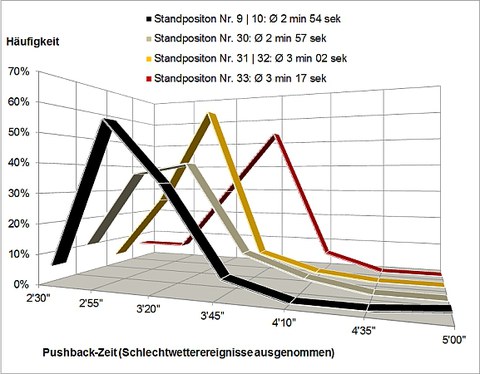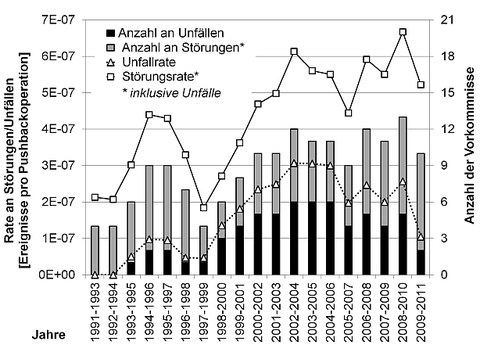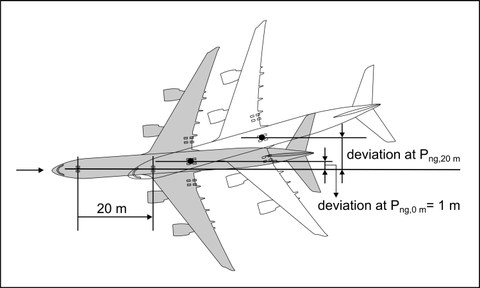Entwicklung eines Modells zur Verhinderung von Kollisionen beim Pushback von Luftfahrzeugen (Pushback Collision Prevention System)
Die zunehmend beengte Situation auf Flughafenvorfeldern verlangt von allen Beteiligten am Vorfeldbetrieb sehr viel Aufmerksamkeit und Sorgfalt, um Unfälle und Betriebsstörungen zu vermeiden. Insbesondere das Zurückdrücken eines Luftfahrzeuges aus seiner Standplatzposition durch externes Gerät (Pushback) erfordert vom Fahrer des Pushback-Fahrzeuges (Schlepper) aufgrund der schlechten Rundumsicht viel Erfahrung und Können, um das Luftfahrzeug innerhalb des vorgegebenen engen Korridors ohne Kollisionen auf den Zielrollweg/-rollgasse (Taxilane) zu pushen. Zeitdruck, hohe Verkehrsdichten und räumliche Enge machen diese Aufgabe auch in Zukunft nicht einfacher. Eine adäquate Systemunterstützung verspricht daher einen Sicherheitsgewinn und im Falle wetterbedingt-schlechter Sichtverhältnisse auch einen Kapazitätsgewinn für den Vorfeldverkehr. Zur Unterstützung des Prozesses Pushback wird daher ein System mit geeigneter Anzeige entwickelt, was zunächst die Situationslage mit den potenziellen, (vorerst) festen Hindernissen sowie die Position und Dimensionen des zu pushenden Luftfahrzeuges geeignet darstellt. Des Weiteren soll dem Nutzer der mögliche Bewegungskorridor für das zu pushende Luftfahrzeug als Sollpfad sowie die Gefahr bei Annäherung zu festen Objekten geeignet zur Anzeige gebracht werden. Es liegt nahe, dass die Nutzung einer derartigen Systemunterstützung primär dem Pushback-Fahrer zuzuordnen ist. Zieht man jedoch die Möglichkeit des eigenständigen Verlassens der Standplatzposition durch das Luftfahrzeug (bspw. zukünftig mittels eTaxiing) in Betracht, wird deutlich, dass ein Prozess unterstützendes System auch für den (redundanten) Einsatz im Cockpit interessant scheint.
Spezielle Forschungsaspekte im Rahmen von Pushback CoPS

Pushback-Prozesszeiten in Abhängigkeit der Standposition auf dem Vorfeld des Flughafens Dresden (in Ingenieursspiegel, 01/2013)
Der Pushback-Prozess ist in der verfahrensseitigen und technischen Ausgestaltung in den wesentlichen Facetten zwar gleich, weist aber im Detail einige Unterschiede auf, sodass man nicht von einem weltweit standardisierten Verfahren sprechen kann. Einfluss - speziell auf die Prozesszeiten - nehmen zudem Wetter- und Sichtbedingungen sowie auch die vorherrschende Hinderniskulisse, wie mittels Prozessanalyse von Pushback-Vorgängen am Flughafen Dresden quantitativ nachgewiesen wurde. Die Ergebnisse dienen der besseren Prädiktion von Bodenprozesszeiten und sind im Rahmen des Forschungsprojektes Dynamische Prozessoptimierung von großem Interesse. Des Weiteren legen zukünftig eingesetzte Techniken (bspw. eTaxiing) alternative Verfahrensweisen für den Pushback nahe. Gekoppelt mit einer adäquaten Systemunterstützung kann damit auch die identifizierte Lücke eines zukünftig sicht-unabhängigen Gate-to-Gate-Prozesses geschlossen werden, welche durch den seitens des A-SMGCS konzeptionell nicht eingebundenen Pushback-Prozess verursacht ist.
Publikationen
- H. Fricke, M. Schultz, F. Dieke-Meier, T. Kunze und B. Oreschko (2013). Effizientes Bodenprozessmanagement unter Berücksichtigung stochastischer Planabweichungen, Ingenieurspiegel, 01/2013
- F. Dieke-Meier und H. Fricke (2012). Expectations from a steering control transfer to cockpit crews for aircraft pushback, International Conference on Application and Theory of Automation in Command and Control Systems (ATACCS), London
- Uwe Pollack (2011). Erstellung eines Verfahrenskonzepts für den Pushback- und Roll-Prozess unter Nutzung neuer technischer Systemlösungen, Studienarbeit, Professur für Technologie und Logistik des Luftverkehrs, TU Dresden
- Jan Keller (2010). Untersuchungen zur Abhängigkeit der Pushback-Prozesszeiten von äußeren, wetterbedingten Faktoren auf dem Vorfeld sowie dem Pushback-Verfahren, Studienarbeit, Professur für Technologie und Logistik des Luftverkehrs, TU Dresden

Pushback-Kollisionsvorfälle und zugehörige Unfall-/Störungsraten an U.S. amerikanischen Flughäfen, 1991-2011 (in Proc. ATACCS 2013)
Glücklicherweise sind die Schadensausmaße an Luftfahrzeugen bei Vorfällen während des Pushback im Vergleich zum eigentlichen Flugbetrieb relativ gering. Dennoch sind Pushback-Vorfälle mit wirtschaftlichen Schäden verbunden, die auch aufgrund deren Häufigkeiten nicht unerheblich sind und daher kaum die mangelnde Aufmerksamkeit von Forschung und Industrie für die Problemlage erklären. Nur vereinzelt und teils indirekt weisen Studien insbesondere auf das Risiko von (tödlichen) Verletzungen von assistierenden Bodenmitarbeitern beim Pushback hin. Die Forschungsarbeiten des Lehrstuhls beschäftigen sich daher auch mit der Bewertung der Sicherheit von aktuell etablierten Pushback-Verfahren. Die Ergebnisse einer deterministischen Analyse von Unfällen und betrieblichen Störungen an U.S. amerikanischen Flughäfen im Zeitraum von 1991-2011 zeigen, dass durchaus eine dringliche Notwendigkeit besteht, den Pushback-Prozess sicherer zu gestalten. So verletzt die ermittelte Rate von Unfällen mit tödlichem Ausgang den definierten Sicherheitsgrenzwert von 1x10-8 Unfälle pro Luftverkehrsoperation am Boden (A-SMGCS TLS). Auch Kollisionen von gepushten Luftfahrzeugen mit Objekten, einhergehend mit substantiellen Schäden an den Luftfahrzeugen, treten häufiger auf als ursprünglich angenommen und motivieren die Entwicklung eines Pushback-Unterstützungssystems. Untersucht wurden bisher 189 aufgezeichnete Vorkommnisse, die gemäß ihren Schadensfall in die vier Kategorien klassifiziert wurden:
- Kategorie 1: Beschädigung des gepushten LFZ oder eines anderen LFZ/Objektes durch die Kollision des gepushten LFZ mit einem anderen LFZ oder einer festen Flughafeninfrastruktureinrichtung, wie bspw. das Terminal, dessen direkt angeschlossenen Fluggastbrücken, Zäune oder Lichtmasten
- Kategorie 2: Beschädigung des gepushten LFZ und/oder des Schleppers bzw. -equipments durch den Pushback-Vorgang selbst, bspw. durch eine Kollision mit dem Schlepper
- Kategorie 3: Beschädigung des gepushten LFZ und/oder des Bodenfahrzeuges/-equipments aufgrund einer Kollision mit einem Bodenfahrzeug/-equipment
- Kategorie 4: (tödlich) verletztes Boden-/Crewpersonal beim Pushback.
Publikationen
- F. Dieke-Meier, T. Kalms, H. Fricke und M. Schultz (2013). Modeling aircraft pushback trajectories for safe operations, International Conference on Application and Theory of Automation in Command and Control Systems (ATACCS), Neapel
- F. Dieke-Meier und H. Fricke (2012). The need for a collision prevention system for the pushback of aircraft, International Council of the Aeronautical Sciences (ICAS), Brisbane
- György Szilagyi (2012). Entwicklung und Implementierung eines Modells zur Abbildung der Jet blast Gefahrenlage auf Flugplatzvorfeldern, Diplomarbeit, Professur für Technologie und Logistik des Luftverkehrs, TU Dresden
- Jana Ludwig (2011). Untersuchung zur Auswirkung des Jet blast von Luftfahrzeugen im Rahmen der Entwicklung einer Sicherheitsanzeige für den Pushback, Studienarbeit, Professur für Technologie und Logistik des Luftverkehrs, TU Dresden
- Stefanie Hahn (2010). Untersuchung zur Herleitung eines Target Level of Safety für den Pushback-Prozess auf dem Flughafenvorfeld, Studienarbeit, Professur für Technologie und Logistik des Luftverkehrs, TU Dresden

Beispielhaftes Pushback-Manöver (in Proc. ATACCS 2013)
Die Vorhersage und Bewertung möglicher Gefahrensituationen während des Pushback sowie die Empfehlung eines idealen Weges/Bewegungskorridors erfordert die Abbildung der Luftfahrzeug-Rollbewegung als Trajektorie. Im Gegensatz zu gängigen Rollverkehrssimulationen genügt es hierbei nicht, das Luftfahrzeug über einen einzigen Referenzpunkt zu definieren. Minimalste Abstände auf dem Flugplatzvorfeld bedingen eine exakte Kenntnis der Position des Luftfahrzeuges bezüglich Hindernisse. Um Bewegungsabläufe, speziell das Schleppkurvenverhalten von Luftfahrzeugen präzise abzubilden, sind zwei Referenzpunkte bzw. die entsprechenden Trajektorien des Bugfahrwerkes und des Hauptfahrwerkes erforderlich. Basierend auf kinematischen Zusammenhängen wird ein Modell zur Abbildung von Pushback-Trajektorien erstellt und validiert. Zudem erfolgt die Identifikation von als ideal im Sinne des minimalen Kollisionsrisikos eingestuften Trajektorien.
Publikationen
- F. Dieke-Meier, T. Kalms, H. Fricke und M. Schultz (2013). Modeling aircraft pushback trajectories for safe operations, International Conference on Application and Theory of Automation in Command and Control Systems (ATACCS), Neapel
- Thomas Kalms (2012). Implementierung und Validierung eines echtzeitfähigen Modells zur Abbildung von Luftfahrzeugbewegungen beim Pushback, Diplomarbeit, Professur für Technologie und Logistik des Luftverkehrs, TU Dresden
- Stefan Böhm (2010). Entwicklung eines Modells zur Abbildung von Roll- und Pushbackbewegungen von Luftfahrzeugen auf dem Flughafenvorfeld, Studienarbeit, Professur für Technologie und Logistik des Luftverkehrs, TU Dresden
Tangierend werden ebenfalls die technischen Möglichkeiten zur echtzeitfähigen Positionsdarstellung des Schlepper-Luftfahrzeug-Verbundes sowie (beweglicher) Hindernisse untersucht. Die Herausforderung ist hierbei der sehr enge Verfahrensraum des Vorgangs Pushback, der möglichst exakte Positionsdaten verlangt, um eine hohe Sicherheit und Nutzerakzeptanz zu erreichen. Die Untersuchungen hierzu konzentrieren sich auf die Identifizierung von Anforderungen an die bereitzustellende Technik (Systeme, Sensorik, Kommunikationstechnik) sowie der Prüfung von aktuellen technischen Lösungen hinsichtlich deren Eignung für eine Anwendung im Rahmen von Pushback CoPS.
Publikationen
- Matthias Beck (2012). Modellierung von Systemeigenschaften der Kommunikationstechnik WiMAX zur Prüfung deren Einsetzbarkeit für den systemunterstützten Pushback von Luftfahrzeugen, Studienarbeit, TU Berlin/TU Dresden
- Thomas Kalms (2010). Modellierung des Systemfehlers als Positionsablage eines auf dem Vorfeld rollenden Luftfahrzeuges bei Nutzung bordseitiger INS/IRS-Daten, Studienarbeit, Professur für Technologie und Logistik des Luftverkehrs, TU Dresden
- Siehe auch Forschungsprojekt Analyse und Bewertung von 3D Punktwolken-basierten Lagedarstellungen zur effektiven Risikominderung auf dem Flughafenvorfeld
